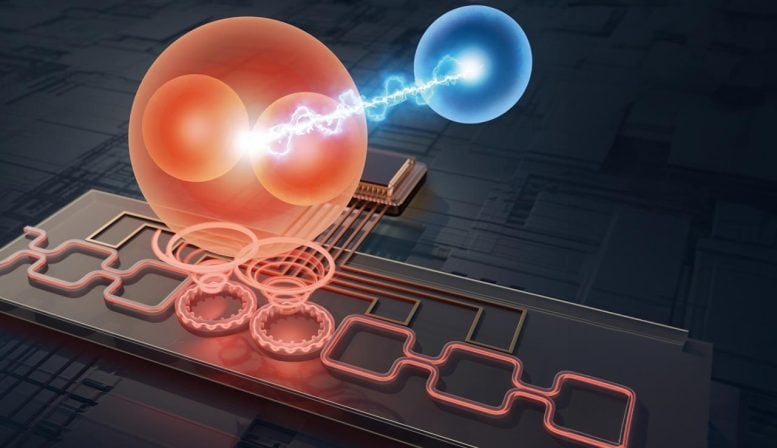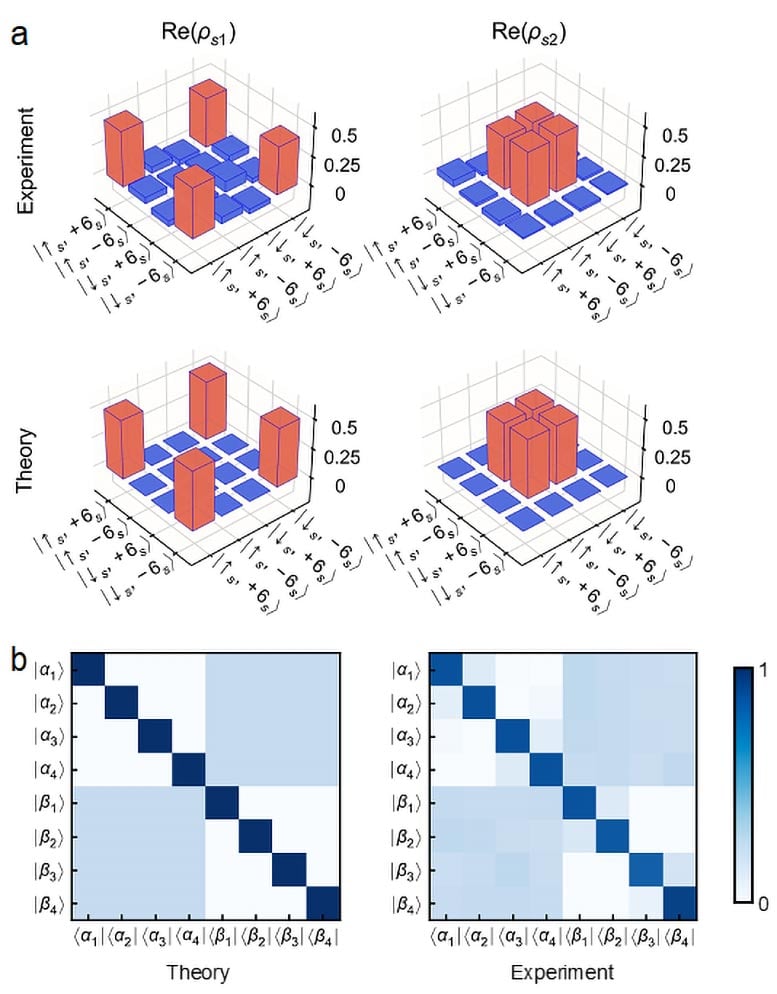
Figure 1. The signal photon, manipulated by the integrated photonic circuit, creates a 4D qudit represented by the set of orange spheres. Meanwhile, the idler photon, represented by the blue sphere, acts as a remote control for the signal photon.
Credit: Haoqi Zhao, Yichi Zhang, Zihe Gao, Jieun Yim, Shuang Wu, Natalia M. Litchinitser, Li Ge, and Liang Feng, edited
Researchers have developed a breakthrough method for quantum information transmission using light particles called qudits, which utilize the spatial mode and polarization properties to enable faster, more secure data transfer and increased resistance to errors.
This technology could greatly enhance the capabilities of a quantum internet, providing long-distance, secure communication, and leading to the development of powerful quantum computers and unbreakable encryption.
Scientists have made a significant breakthrough in creating a new method for transmitting quantum information using particles of light called qudits. These qudits promise a future quantum internet that is both secure and powerful.
Traditionally, quantum information is encoded on qubits, which can exist in a state of 0, 1, or both at the same time (superposition). This quality makes them ideal for complex calculations but limits the amount of data they can carry in communication. Conversely, qudits can encode information in higher dimensions, transmitting more data in a single go.
Qubits vs. Qudits
Qubits and qudits are both units of quantum information, but they differ primarily in their capacity to hold information. A qubit, the basic unit used in <span class="glossaryLink" aria-describedby="tt" data-cmtooltip="
quantum computingPerforming computation using quantum-mechanical phenomena such as superposition and entanglement.” data-gt-translate-attributes=”[{"attribute":"data-cmtooltip", "format":"html"}]” tabindex=”0″ role=”link”>quantum computing, can exist in two states simultaneously due to quantum superposition, typically represented as 0 and 1, like the bits in classical computing. This allows it to perform complex computations more efficiently than classical bits.
Qudits, on the other hand, are a generalization of qubits and can exist in d states simultaneously, where d > 2. This higher dimensionality allows qudits to hold more information than qubits, potentially leading to more efficient data processing and communication in quantum systems, as they can perform operations that would require multiple qubits with fewer qudits, increasing efficiency and reducing complexity in quantum algorithms.
Leveraging Light Properties for Advanced Qudits
The new technique harnesses two properties of light – spatial mode and polarization – to create four-dimensional qudits. These qudits are built on a special chip that allows for precise manipulation. This manipulation translates to faster data transfer rates and increased resistance to errors compared to conventional methods.
One of the key advantages of this approach is the qudits’ ability to maintain their quantum properties over long distances. This makes them perfect for applications like satellite-based quantum communication, where data needs to travel vast distances without losing its integrity.

Figure 2. (a) The experimentally retrieved (upper row) and theoretically predicted (lower row) density matrices of two selected quantum states. (b) Theoretically (left panel) and experimentally retrieved (right panel) probability-of-detection matrix. Credit: Haoqi Zhao, Yichi Zhang, Zihe Gao, Jieun Yim, Shuang Wu, Natalia M. Litchinitser, Li Ge, and Liang Feng
The Mechanism of Quantum Entanglement
The process starts with generating a special entangled state using two photons. Entanglement is a phenomenon where two particles become linked, sharing the same fate regardless of physical separation. In this case, one <span class="glossaryLink" aria-describedby="tt" data-cmtooltip="
” data-gt-translate-attributes=”[{"attribute":"data-cmtooltip", "format":"html"}]” tabindex=”0″ role=”link”>photon (the signal photon) is manipulated on the chip to create a 4D qudit using its spatial mode and polarization. The other photon (idler photon) remains unchanged and acts as a remote control for the signal photon (Fig. 1).
By manipulating the idler photon, scientists can control the state of the signal photon and encode information onto it (Fig. 2).
Future Potential of Quantum Qudit Technology
This new method has the potential to revolutionize the field of quantum communication. It paves the way for a high-speed quantum internet that can transmit massive amounts of data securely over long distances. Additionally, it can lead to the development of unbreakable encryption protocols and contribute to the creation of powerful quantum computers capable of tackling problems beyond the reach of classical computers.
The researchers are currently focusing on improving the <span class="glossaryLink" aria-describedby="tt" data-cmtooltip="
” data-gt-translate-attributes=”[{"attribute":"data-cmtooltip", "format":"html"}]” tabindex=”0″ role=”link”>accuracy of the qudits and scaling up the technology to handle even higher dimensions. They believe this approach has the potential to revolutionize quantum communication.
Reference: “Integrated preparation and manipulation of high-dimensional flying structured photons” by Haoqi Zhao, Yichi Zhang, Zihe Gao, Jieun Yim, Shuang Wu, Natalia M. Litchinitser, Li Ge and Liang Feng, 29 June 2024, eLight.
DOI: 10.1186/s43593-024-00066-6
